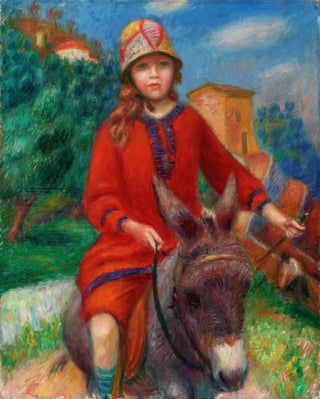Art print | The Promenade - William James Glackens


View from behind

Frame (optional)
In the vibrant world of early 20th-century American art, "The Promenade" by William James Glackens stands out for its cheerful atmosphere and striking depiction of urban life. This artwork, emblematic of the American Impressionist movement, captures a moment of conviviality and lightness, where figures blend harmoniously into a lively cityscape. Glackens, with his attentive gaze and luminous palette, manages to convey a sense of joy and freedom, inviting the viewer to immerse themselves in this scene of life. Through this art print, the artist evokes universal emotions, making the piece timeless and accessible.
Style and uniqueness of the work
One of the most fascinating aspects of "The Promenade" lies in Glackens' unique style, which combines Impressionist techniques with a more figurative approach. The fluid brushstrokes and vibrant colors bring this scene to life, creating a striking contrast between the figures and their surroundings. The figures, though stylized, are imbued with a certain warmth, each smile and gesture telling a story. The dynamic composition, with its leading lines and perspectives, guides the viewer’s eye through the piece, enhancing the sense of movement and interaction. This blend of modernity and tradition, coupled with meticulous attention to detail, makes this work a perfect example of the artistic innovation of its time.
The artist and his influence
William James Glackens, a prominent member of the "Ashcan School," played a crucial role in the evolution of American art in the early 20th century. Influenced by European masters, he adapted their style to American reality, capturing the essence of urban life with a unique sensitivity. His ability to depict scenes of everyday life, while incorporating elements of pictorial experimentation, paved the way for many contemporary artists. Glackens was also a passionate advocate of modern art, encouraging his peers to explore new techniques and move away from academic conventions. His legacy endures today, inspiring generations of

Matte finish

View from behind

Frame (optional)
In the vibrant world of early 20th-century American art, "The Promenade" by William James Glackens stands out for its cheerful atmosphere and striking depiction of urban life. This artwork, emblematic of the American Impressionist movement, captures a moment of conviviality and lightness, where figures blend harmoniously into a lively cityscape. Glackens, with his attentive gaze and luminous palette, manages to convey a sense of joy and freedom, inviting the viewer to immerse themselves in this scene of life. Through this art print, the artist evokes universal emotions, making the piece timeless and accessible.
Style and uniqueness of the work
One of the most fascinating aspects of "The Promenade" lies in Glackens' unique style, which combines Impressionist techniques with a more figurative approach. The fluid brushstrokes and vibrant colors bring this scene to life, creating a striking contrast between the figures and their surroundings. The figures, though stylized, are imbued with a certain warmth, each smile and gesture telling a story. The dynamic composition, with its leading lines and perspectives, guides the viewer’s eye through the piece, enhancing the sense of movement and interaction. This blend of modernity and tradition, coupled with meticulous attention to detail, makes this work a perfect example of the artistic innovation of its time.
The artist and his influence
William James Glackens, a prominent member of the "Ashcan School," played a crucial role in the evolution of American art in the early 20th century. Influenced by European masters, he adapted their style to American reality, capturing the essence of urban life with a unique sensitivity. His ability to depict scenes of everyday life, while incorporating elements of pictorial experimentation, paved the way for many contemporary artists. Glackens was also a passionate advocate of modern art, encouraging his peers to explore new techniques and move away from academic conventions. His legacy endures today, inspiring generations of






